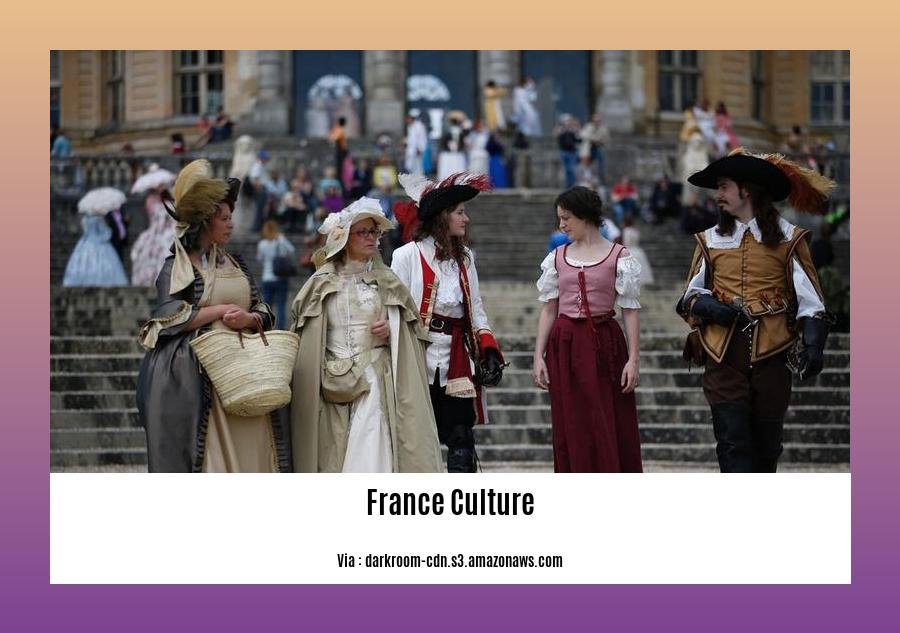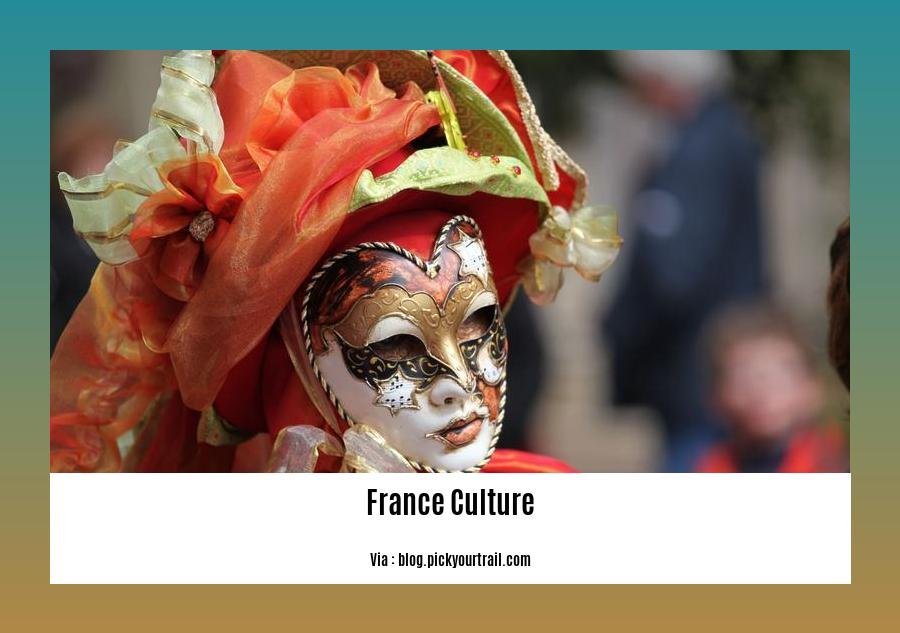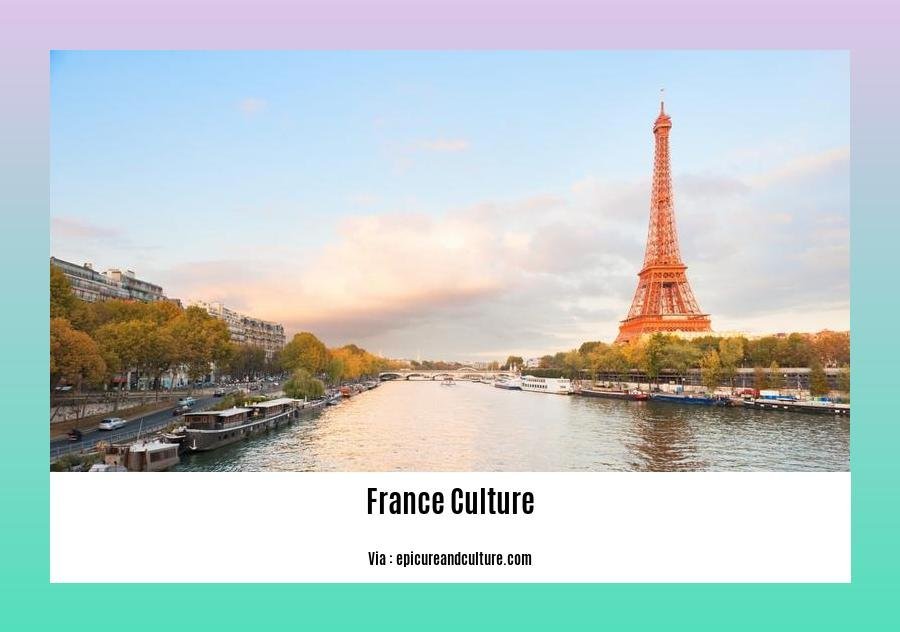Uncover the captivating world of French culture through this delightful journey into its unique traditions and practices. From the symbolic significance of the baguette to the fascinating history of the iconic Eiffel Tower, prepare to be enthralled as we unveil Fun Facts About France Culture: Unveiling the Enchanting Tapestry of French Traditions.
Key Takeaways:
- The Lumière brothers invented cinema in France in 1895.
- French is spoken as the official language in 29 countries worldwide and is the second most studied foreign language after English.
- The French place a high value on politeness, formality, and proper etiquette.
- France has a reputation as a culinary paradise, boasting a rich and varied cuisine.
- Bread is consumed at every meal, and cheese is a staple food in French cuisine.
Fun Facts About France Culture

France is a country brimming with captivating traditions and unique practices. Discover a treasure trove of intriguing tidbits that unravel the essence of its rich cultural tapestry.
Language and Communication
Romance personified: Did you know that the French language has given us the term “amour”? It’s true, the French word for love has become a universal symbol of romance, embodying the passionate nature of the French spirit.
A global language: Oh, là là! French is spoken in an impressive 29 countries worldwide. It’s the second most studied foreign language after English, connecting people across borders with its melodic intonations.
Politesse, s’il vous plaît: The French embrace politeness as an art form. They value etiquette and manners, so a “bonjour” and “merci” go a long way in showing respect.
Cuisine and Gastronomy
Bread, cheese, wine – oh my!: The French take bread seriously. It’s a staple at every meal, crusty baguettes gracing the table alongside a variety of cheeses. And let’s not forget the wine, a quintessential part of French gastronomy.
Pâtisserie paradise: From delicate macarons to the iconic mille-feuille, France is a pastry lover’s heaven. These delectable treats are a testament to the country’s culinary artistry.
That escargot, though: Escargots, or snails, are a French delicacy that might raise an eyebrow or two. But hey, when in France, try something new – you might just be pleasantly surprised!
Culture and Lifestyle
Cinéma français: The world of cinema owes its birth to France. In 1895, the Lumière brothers, two Frenchmen, unveiled the magic of motion pictures, forever changing the entertainment landscape.
Fashion forward: Paris, the fashion capital of the world, sets the trends that the rest of the world follows. From haute couture to prêt-à-porter, French style is synonymous with elegance and sophistication.
Bonjour, bisous: The French have a unique way of greeting each other. A kiss on both cheeks, or “la bise,” is a common practice among friends and acquaintances.
Fun Facts Table
| Aspect | Fun Fact |
|---|---|
| Language | French is the second most studied foreign language after English, spoken in 29 countries worldwide. |
| Cuisine | Baguette, cheese, and wine are staples of the French diet. |
| Cinema | The Lumière brothers, from France, invented the cinematograph, the forerunner of the modern movie camera. |
| Fashion | Paris is renowned as the fashion capital of the world. |
| Etiquette | The French value politeness and manners, often using “bonjour” and “merci” in everyday interactions. |
So, there you have it, a delightful array of fun facts about France culture. From its language and cuisine to its fashion and cinematic legacy, France continues to captivate hearts and minds with its vibrant cultural tapestry.
Did you know that Mexico is a land of culinary wonders? From tacos to tamales, Mexican food is a blend of indigenous and Spanish influences that has spread worldwide. Unravel the secrets of Mexican cuisine as we explore some fascinating facts about its history, ingredients, and unique flavors. facts about Mexico food
Have you heard of the interesting legend behind the creation of tacos? Or the curious story of how mole poblano became a national dish? Discover these and other fun facts about Mexican food that will leave you craving for more. fun facts about Mexico food
Did you know that Mexican cuisine has been recognized by UNESCO as an Intangible Cultural Heritage of Humanity? Learn why Mexican food is so much more than just tacos and burritos as we delve into the rich history, traditions, and innovations that make it one of the most beloved cuisines in the world. interesting facts about Mexico food
Le Tour de France: A journey through the heart of French cycling culture and history

Cycling, in the heart of French culture, has reached legendary proportions, with its most remarkable form being Le Tour de France: A journey through the heart of French cycling culture and history.
The Tour, as it’s commonly called, is a grueling 21-day event, where cyclists battle it out on wheels across the stunning French countryside. It’s a spectacle that has captivated the world for over a century.
History of the Tour de France
Henri Desgrange, a cycling enthusiast and journalist, founded the Tour de France in 1903 to boost sales for his newspaper, l’Auto. The first race covered 2,428 kilometers (1,509 miles) in six stages, with Maurice Garin emerging as the inaugural champion. From then on, the Tour has become an annual event, except during the two World Wars, leaving an indelible mark on French culture and cycling history.
The Race Route
The Tour’s route changes every year, traversing diverse landscapes, from the majestic Alps to the rolling hills of the French countryside. The iconic yellow jersey, awarded to the overall leader, signifies the race’s prestige and difficulty. With grueling mountain stages, cobblestone sections, and time trials, the Tour pushes cyclists to their physical and mental limits.
The French Connection
The Tour de France is deeply intertwined with French culture. Towns and villages along the route come alive, with spectators lining the streets, cheering on the cyclists. The race is a celebration of French heritage, with each stage showcasing regional specialties, from local cuisine to cultural events.
Key Takeaways:
Le Tour de France, the world’s most prestigious cycling race, has been held annually since 1903, except during the World Wars.
Founded by Henri Desgrange, the race was initially intended to boost newspaper sales.
The Tour’s route changes each year, showcasing France’s diverse landscapes and cultural heritage.
The iconic yellow jersey signifies the overall race leader.
The race attracts millions of spectators, with towns and villages along the route celebrating the event.
Le Tour de France is a symbol of French national pride and a testament to the country’s passion for cycling.
Source:
– Tour de France – Encyclopedia Britannica
– Tour de France History: A Brief Introduction – BikeTips
French gastronomy: Exploring the art of fine dining and the importance of food in French life
Gastronomy is an affair of the heart in France, where food is elevated to an art form, and dining is a cherished ritual. French cuisine, with its symphony of flavors and textures, has left an indelible mark on the world’s culinary landscape. Join us as we delve into the rich tapestry of French gastronomy, where every meal is a celebration of life.
A Culinary Journey Through the Ages
French cuisine has evolved over centuries, shaped by diverse influences from royal courts to humble kitchens. In the 17th century, under the reign of Louis XIV, French gastronomy reached new heights with the introduction of elaborate banquets and the rise of master chefs. The 19th century witnessed the emergence of grand restaurants and the birth of nouvelle cuisine, which emphasized fresh, seasonal ingredients and lighter dishes. Today, French gastronomy continues to innovate, blending tradition with contemporary influences, showcasing the boundless creativity of French chefs.
The Art of Fine Dining
Fine dining in France is a multi-sensory experience, where every element, from the ambiance to the service, is meticulously orchestrated to create a memorable occasion. French restaurants take pride in their extensive wine lists, expertly paired with each dish to enhance the flavors. The leisurely pace of French dining allows diners to savor each course, appreciating the intricate flavors and textures that make French cuisine so special.
The Importance of Food in French Life
Food is deeply intertwined with French culture and identity. The French take immense pleasure in dining, viewing it as a social occasion to connect with friends and family. The traditional French meal consists of three courses: an entrée (starter), a plat principal (main course), and a dessert. Each course is carefully chosen to complement the others, creating a harmonious and balanced meal.
Key Takeaways:
French gastronomy is a UNESCO-recognized cultural heritage, renowned for its unique cuisine and way of life.
French dishes emphasize fresh, seasonal ingredients, herbs, and spices, creating subtle yet flavorful dishes.
Fine dining in France is an elevated experience, characterized by elegant ambiance, impeccable service, and expertly paired wines.
The French take pride in their three-meal day, savoring each course and viewing dining as a social occasion.
French gastronomy has evolved over centuries, from royal feasts to nouvelle cuisine, showcasing the country’s rich culinary history.
Sources:
French Gastronomy: A Culinary Journey
Fashion and Style in France: Unveiling the Cultural Significance of Dressing with Elegance
Key Takeaways:
Fashion holds a significant place in French culture, influencing social life and the economy for centuries.
French artisans have long crafted luxurious fabrics and exquisite designs, contributing to the country’s reputation as a fashion hub.
Paris, renowned as the global capital of couture, sets trends and showcases iconic fashion houses.
French dressing etiquette emphasizes elegance, with a focus on quality pieces and understated sophistication.
The French embrace personal style, valuing individuality and creativity in their fashion choices.
French Fashion: A Timeless Legacy
France’s fashion history traces back to the 15th century when its textile industry flourished. During the reign of Louis XIV, the “Sun King,” elaborate court attire and opulent fabrics became symbols of power and luxury. By the 18th century, Paris had emerged as a fashion capital, attracting royalty and nobility from across Europe. The city’s vibrant fashion scene thrived, with renowned designers like Coco Chanel and Christian Dior shaping the industry’s trajectory.
The Art of Dressing with Elegance
For the French, dressing with elegance is an art form, blending sophistication, simplicity, and individuality. While they appreciate high-end fashion brands, they also value timeless pieces and well-made basics that can be mixed and matched to create a unique style. French fashion embraces a neutral color palette, allowing statement accessories and scarves to add pops of color and personality.
The French Approach to Fashion
The French approach to fashion emphasizes quality over quantity. They invest in well-crafted garments that can withstand the test of time, rather than chasing fleeting trends. This sustainable mindset promotes a mindful and conscious approach to fashion, prioritizing durability and versatility. French dressing often revolves around a capsule wardrobe, featuring interchangeable pieces that can be styled for various occasions.
Fashion and French Identity
Fashion plays a crucial role in shaping French identity, reflecting the country’s rich history, artistry, and cultural heritage. It is a source of national pride and a symbol of elegance and refinement worldwide. The French take great pride in their appearance and see fashion as a means of self-expression and cultural identity.
In Conclusion:
Fashion in France is more than just about clothing; it is an integral part of the country’s culture, history, and identity. From the grand catwalks of Paris to the streets of smaller towns, fashion permeates every aspect of French life. Its enduring influence on the global fashion industry continues to shape trends and inspire designers around the world.
Citations:
- The History of French Fashion
- French Style vs. American Style: What’s the Difference?
FAQ
Q1: What fascinating inventions have originated in France?
A1: France has been the birthplace of numerous remarkable inventions, including the revolutionary invention of cinema by the Lumière brothers in 1895.
Q2: How widespread is the French language globally?
A2: French is not only the official language of 29 countries but also ranks as the second most widely learned foreign language worldwide, following English.
Q3: What is the significance of bread and cheese in French cuisine?
A3: Bread holds a special place in French culture, with the French consuming it at every meal. Additionally, cheese is considered a staple food, adding a rich flavor to French dishes.
Q4: What is the French perspective on dining etiquette?
A4: The French are renowned for their politeness and formality during interactions, which extends to dining etiquette. They value proper manners and adhere to specific rules of etiquette while eating.
Q5: What makes French cuisine so unique and recognized worldwide?
A5: French gastronomy has gained international acclaim for its distinctive cuisine and way of life. It emphasizes fresh, natural ingredients, with an emphasis on wine, cheese, olive oil, and seasonal vegetables, creating a culinary experience that is both simple and sophisticated.
- Star Ring Trends: Etsy vs Amazon - March 28, 2025
- Boost Pollinator Habitats: Baby Blue Eyes Sustainable Farming Guide - March 28, 2025
- Protect Big Black Bears: Effective Conservation Strategies - March 28, 2025
















